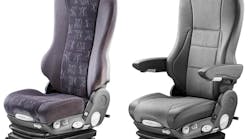What truck driver isn’t familiar with this unpleasant feeling in the summer: back, thighs and buttocks sticking to the seat after hours behind the wheel. The air conditioning only keeps the head and front of the body agreeably cool.
Although cooling systems increase comfort by lowering the air temperature in the cabin, the body continues to absorb energy from sunlight, which it then has to get rid of again in the form of sweat. The backside of the body, which accounts for about 25% of an adult’s surface area, is unavailable for eliminating excess heat because it is covered by the seat and therefore out of range of the circulating air.
Seat manufacturer Grammer offers its Kingman High Performance driver seat with Active Seat Climate Control as “Kingman Climate” for retrofitting. It is operated using three controls: a switch with two air settings, another for selecting either of two heating levels, and an off button. The system ensures a pleasant sitting climate at all temperatures, according to Grammer, in the summer and the winter.
Active Seat Climate Control from Grammer takes advantage of activated charcoal: perspiration that accumulates where the body contacts the seat is removed via the cover material and temporarily stored in a layer of activated charcoal underneath. This keeps the seat’s surfaces pleasantly dry, even in the hottest weather, Grammer claims.
In contrast to conventional seat climatization systems, which achieve a cooling effect by directly blowing air onto the body, the Grammer system supports the natural cooling function of human skin. This avoids the health risks of inducing a draft, the manufacturer says, because body moisture is constantly and gently removed.
Beneath the layer of activated charcoal, there is a ventilation layer through which cool, dry air flows. This level removes moisture from the activated charcoal. As a result, the seat’s occupant experiences a pleasant temperature at all times, with a dry back and buttocks.
After the seat is vacated, the activated charcoal automatically discharges its moisture load. Compared to a seat without climate control, the differences are substantial: the seat’s surface temperature is about 10 percent lower on average and relative humidity is some 20 percent less, according to Grammer's studies.



